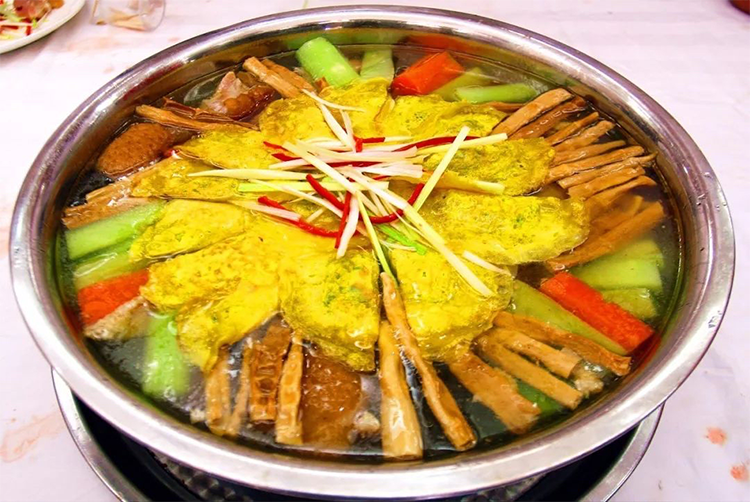Zhangjiajie Rock-Ear Steamed Chicken
1. A Cliffside Treasure Through the Ages: Origins and History
In picturesque Zhangjiajie, Hunan Province, a centuries-old delicacy awaits — rock-ear steamed chicken. This dish dates back to the Ming and Qing dynasties, rooted in the mountain traditions of the Tujia and Miao peoples. Locals combined the rare rock ear (a lichen gathered from sheer sandstone cliffs) with free-range chickens, steaming them slowly to preserve their natural flavors.
Historically, rock-ear steamed chicken was reserved for honored guests and festive occasions due to its precious ingredients and long preparation time. Over generations, it evolved from a ceremonial dish into a signature of Zhangjiajie’s mountain cuisine.
2. Nature and Culture in Harmony: Cultural Significance
For Zhangjiajie residents, rock-ear steamed chicken is more than just food — it embodies respect for nature and tradition. Rock ear, which grows on pristine sandstone cliffs, is believed to absorb the spirit of the mountains. Free-range chickens roam the hillsides, giving their meat a natural, earthy aroma.
Together, these ingredients symbolize the unity between people and their environment. When guests arrive or festivals are celebrated, serving a steaming bowl of rock-ear chicken expresses hospitality, heritage, and pride.
3. The Mountain’s Gifts: What Makes the Ingredients Special
This dish’s essence lies in its two core ingredients: rock ear and free-range chicken. Rock ear thrives above 800 meters on Zhangjiajie’s cliffs and must be hand-harvested by skilled climbers — making it rare and valuable. It has a dark, jelly-like texture and is rich in minerals.
The region’s free-range chickens, nourished by spring water and wild grains, yield firm, flavorful meat. Supporting ingredients such as red dates, goji berries, and ginger add sweetness and balance while highlighting, rather than masking, the mountain’s natural taste.
4. Slow-Steamed Artistry: Traditional Preparation Revealed
Preparing rock-ear steamed chicken is a lesson in patience and precision. A cleaned whole chicken is stuffed with soaked rock ear, red dates, and goji berries, then placed in a clay or wooden steaming basin. Water is added, and the basin is steamed gently for 4–6 hours.
During this slow process, the rock ear releases its gelatin into the broth while the chicken becomes soft and tender. The final result — a clear, golden, collagen-rich soup — reflects time, skill, and the quiet art of mountain cooking.

5. Flavor Layers and Texture: Tasting Notes
When the lid lifts, a deep, savory aroma fills the air. The broth is clear but richly flavored; the first sip offers the chicken’s umami, followed by the mountain fragrance of the rock ear and the mild sweetness of red dates and goji berries.
After hours of steaming, the meat falls effortlessly from the bone, while the rock ear remains silky yet pleasantly chewy. The soup — delicate yet powerful — feels like a drinkable essence of Zhangjiajie’s mountains.
6. Local Dining Customs: How to Enjoy It Authentically
In Zhangjiajie, the steaming basin is often brought to the table intact, a sign of respect and generosity. Diners first sip the clear broth, then share the chicken pieces. Many locals pour the broth over rice, letting each grain soak in the rich flavor.
To balance the dish’s natural richness, side dishes like pickled radish or chili paste are often served. Minimal seasoning is used overall, allowing the ingredients’ pure mountain taste to shine through.
7. Tips for the Ultimate Tasting Experience
- Best season: Autumn and winter, when rock ear is plump and chickens are fattier.
- Where to eat: Local restaurants and farmhouse eateries that specialize in traditional Tujia dishes.
- Ordering tips: Confirm the use of real cliff-harvested rock ear (not black fungus) and local free-range chicken.
- Preparation time: Since the dish takes hours to steam, call ahead to reserve.
- Pairings: Share one basin among 2–4 people, and enjoy it with berry tea or rice wine for a true Xiangxi meal.
8. Traveler’s Food Map: Practical Advice
To taste genuine rock-ear steamed chicken, head to Zhangjiajie City or the Wulingyuan Scenic Area. Authentic versions are found in traditional Xiangxi restaurants and countryside homestays.
Expect to pay around ¥80–150 per person, perfect for sharing. Some farmhouse restaurants even serve it inside the national park, adding a touch of mountain authenticity to the experience.

9. Recreating a Taste of Xiangxi at Home: A Simple Recipe
While nothing rivals the mountain version, a home-cooked adaptation can still capture its essence.
Ingredients:
- 1.5 kg free-range chicken
- 50 g dried rock ear (soaked for 4 hours)
- 6 red dates, a handful of goji berries, sliced ginger
- Water and salt to taste
Steps:
- Soak and clean the rock ear thoroughly to remove grit.
- Place all ingredients in a heatproof bowl and add enough water to cover.
- Cover tightly and steam over a water bath for 3–4 hours.
- Season lightly with salt before serving.
Longer steaming produces a richer, silkier broth and ensures the flavors fully meld.
10. Summary: A Bowl of Zhangjiajie’s Spirit
Rock-ear steamed chicken is a culinary portrait of Zhangjiajie’s landscape and heritage. From the cliffs that nurture rock ear to the hills that raise free-range chickens, every bite captures nature’s purity and human care.
Whether you enjoy it in a local farmhouse or recreate it in your own kitchen, this Hunan specialty offers a comforting, nourishing taste of Xiangxi’s warmth, patience, and pride.


